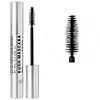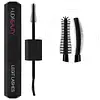Milk Makeup Kush Volumizing Mascara Versus Huda Beauty Legit Lashes Double-Ended Volumizing And Lengthening Mascara
What's inside
What's inside
 Key Ingredients
Key Ingredients

 Benefits
Benefits

 Concerns
Concerns

 Ingredients Side-by-side
Ingredients Side-by-side

Water
Skin ConditioningParaffin
PerfumingGlyceryl Stearate
EmollientSynthetic Beeswax
Emulsion StabilisingStearic Acid
CleansingAcacia Senegal Gum
MaskingButylene Glycol
HumectantPalmitic Acid
EmollientPolybutene
Oryza Sativa Bran Wax
Skin ConditioningVp/Eicosene Copolymer
Ozokerite
Emulsion StabilisingAminomethyl Propanol
BufferingHydrogenated Vegetable Oil
EmollientPhenoxyethanol
PreservativeStearyl Stearate
EmollientHydroxyethylcellulose
Emulsion StabilisingNylon-6
Papaver Somniferum Seed Oil
EmollientCannabis Sativa Seed Oil
EmollientGlycerin
HumectantHelianthus Annuus Seed Oil
EmollientDipteryx Odorata Seed Extract
MaskingTheobroma Grandiflorum Seed Butter
Skin ConditioningCopernicia Cerifera Cera
EmollientSilica
AbrasiveTropolone
Skin ConditioningAframomum Melegueta Seed Extract
Skin ConditioningHelichrysum Italicum Extract
AntiseborrhoeicCI 77499
Cosmetic ColorantWater, Paraffin, Glyceryl Stearate, Synthetic Beeswax, Stearic Acid, Acacia Senegal Gum, Butylene Glycol, Palmitic Acid, Polybutene, Oryza Sativa Bran Wax, Vp/Eicosene Copolymer, Ozokerite, Aminomethyl Propanol, Hydrogenated Vegetable Oil, Phenoxyethanol, Stearyl Stearate, Hydroxyethylcellulose, Nylon-6, Papaver Somniferum Seed Oil, Cannabis Sativa Seed Oil, Glycerin, Helianthus Annuus Seed Oil, Dipteryx Odorata Seed Extract, Theobroma Grandiflorum Seed Butter, Copernicia Cerifera Cera, Silica, Tropolone, Aframomum Melegueta Seed Extract, Helichrysum Italicum Extract, CI 77499
Water
Skin ConditioningBeeswax
Emulsion StabilisingStearic Acid
CleansingHelianthus Annuus Seed Wax
Skin ConditioningGlyceryl Behenate
EmollientAcacia Senegal Gum
MaskingPolyglyceryl-6 Distearate
EmulsifyingVp/Eicosene Copolymer
Propanediol
SolventCopernicia Cerifera Wax
Aminomethyl Propanediol
BufferingStearyl Stearate
EmollientGlyceryl Caprylate
EmollientStearyl Palmitate
EmulsifyingHydrogenated Starch Hydrolysate
HumectantMethyl Methacrylate Crosspolymer
Phenoxyethanol
PreservativeHydroxyethylcellulose
Emulsion StabilisingPotassium Sorbate
PreservativeParaffin
PerfumingCetyl Palmitate
EmollientCetyl Stearate
EmollientPolyglyceryl-6 Polyricinoleate
EmulsifyingPanthenol
Skin ConditioningLaureth-20
EmulsifyingMethylpropanediol
SolventPolyethylene Terephthalate
Butylene Glycol
HumectantMagnesium Stearate
Cosmetic ColorantCaprylhydroxamic Acid
Behenic Acid
CleansingMicrocrystalline Wax
Emulsion StabilisingArachidic Acid
Cleansing1,2-Hexanediol
Skin ConditioningPalmitic Acid
EmollientSilica
AbrasiveSodium Phosphate
BufferingDisodium Phosphate
BufferingPolysorbate 20
EmulsifyingCI 77499
Cosmetic ColorantCI 77266
Cosmetic ColorantOryza Sativa Bran Wax
Skin ConditioningNylon-6
Water, Beeswax, Stearic Acid, Helianthus Annuus Seed Wax, Glyceryl Behenate, Acacia Senegal Gum, Polyglyceryl-6 Distearate, Vp/Eicosene Copolymer, Propanediol, Copernicia Cerifera Wax, Aminomethyl Propanediol, Stearyl Stearate, Glyceryl Caprylate, Stearyl Palmitate, Hydrogenated Starch Hydrolysate, Methyl Methacrylate Crosspolymer, Phenoxyethanol, Hydroxyethylcellulose, Potassium Sorbate, Paraffin, Cetyl Palmitate, Cetyl Stearate, Polyglyceryl-6 Polyricinoleate, Panthenol, Laureth-20, Methylpropanediol, Polyethylene Terephthalate, Butylene Glycol, Magnesium Stearate, Caprylhydroxamic Acid, Behenic Acid, Microcrystalline Wax, Arachidic Acid, 1,2-Hexanediol, Palmitic Acid, Silica, Sodium Phosphate, Disodium Phosphate, Polysorbate 20, CI 77499, CI 77266, Oryza Sativa Bran Wax, Nylon-6
 Reviews
Reviews

Ingredients Explained
These ingredients are found in both products.
Ingredients higher up in an ingredient list are typically present in a larger amount.
Acacia Senegal Gum has skin soothing, thickening, and formulation stabilizing properties. It comes from the Acacia tree that is native to sub-Saharan Africa.
Butylene Glycol (or BG) is used within cosmetic products for a few different reasons:
Overall, Butylene Glycol is a safe and well-rounded ingredient that works well with other ingredients.
Though this ingredient works well with most skin types, some people with sensitive skin may experience a reaction such as allergic rashes, closed comedones, or itchiness.
Learn more about Butylene GlycolCi 77499 is also hydrated iron III oxide. It is created from mixing red and black iron oxides. This helps give shades of darkness to a product.
Iron III oxides are classified as inorganic chemicals for coloring.
Hydroxyethylcellulose is used to improve the texture of products. It is created from a chemical reaction involving ethylene oxide and alkali-cellulose. Cellulose is a sugar found in plant cell walls and help give plants structure.
This ingredient helps stabilize products by preventing ingredients from separating. It can also help thicken the texture of a product.
This ingredient can also be found in pill medicines to help our bodies digest other ingredients.
Learn more about HydroxyethylcelluloseWe don't have a description for Nylon-6 yet.
Oryza Sativa Bran Wax is wax from the outer layer of a rice kernel. It has moisturizing properties due to its polysaccharides and omega-3 fatty acids content.
This ingredient is a byproduct of milling rice, or the operation to produce a whole grain rice product.
Palmitic Acid is a fatty acid naturally found in our skin and in many plant and animal sources. In cosmetics, it is usually derived from palm oil. It serves many purposes in skincare, acting as a cleanser, emollient, and emulsifier.
As an emollient, palmitic acid helps soften and smooth the skin by preventing water loss. In cleansers, it helps remove oil and dirt while creating foam.
Its emulsifying properties help stabilize products by keeping water and oil-based ingredients from separating.
This may not be suitable for fungal acne-prone skin, as fatty acids like this can sometimes trigger breakouts in sensitive individuals.
Learn more about Palmitic AcidParaffin is a solid created from petroleum. The term 'paraffin' can also refer to either
petroleum jelly or mineral oil.
It has natural occlusive properties which can worsen oily skin. Due to its petrolatum base, this ingredient is not fungal-acne safe.
Phenoxyethanol is a preservative that has germicide, antimicrobial, and aromatic properties. Studies show that phenoxyethanol can prevent microbial growth. By itself, it has a scent that is similar to that of a rose.
It's often used in formulations along with Caprylyl Glycol to preserve the shelf life of products.
Silica, also known as silicon dioxide, is a naturally occurring mineral. It is used as a fine, spherical, and porous powder in cosmetics.
Though it has exfoliant properties, the function of silica varies depending on the product.
The unique structure of silica enhances the spreadability and adds smoothness, making it a great texture enhancer.
It is also used as an active carrier, emulsifier, and mattifier due to its ability to absorb excess oil.
In some products, tiny microneedles called spicules are made from silica or hydrolyzed sponge. When you rub them in, they lightly polish away dead skin layers and enhance the penetration of active ingredients.
Learn more about SilicaStearic Acid is a fatty acid. It is an emollient, emulsifier, and texture enhancer.
As an emollient, stearic acid helps soften skin. It aids the skin's protective barrier by preventing water loss. It also provides a gentle cleansing effect without stripping away natural oils.
Stearic acid may also be used to enhance the texture of products. It can add volume and stabilize ingredients such as water and oil. This can help water and oil ingredients from separating.
Sources of stearic acid include animal or vegetable fats/oils such as coconut or shea. It can be naturally found in butter, cocoa butter, shea butter, vegetable fats, and animal tallow.
This ingredient may not be Malassezia folliculitis, or fungal-acne safe.
Learn more about Stearic AcidStearyl Stearate isn't fungal acne safe.
We don't have a description for Vp/Eicosene Copolymer yet.
Water. It's the most common cosmetic ingredient of all. You'll usually see it at the top of ingredient lists, meaning that it makes up the largest part of the product.
So why is it so popular? Water most often acts as a solvent - this means that it helps dissolve other ingredients into the formulation.
You'll also recognize water as that liquid we all need to stay alive. If you see this, drink a glass of water. Stay hydrated!
Learn more about Water